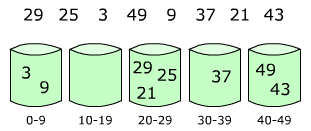Algorithmic Complexity
Logistics
Please make sure you have emailed your github account to Josh.
Pseudocode
It is often useful to use pseudocode when we discuss algorithms. This helps us gloss over syntax details and get to the heart of a problem. It is often helpful to plan in pseudocode before writing. There is no strict syntax for pseudocode, but here are some suggstions:
- no need to declare variables or worry about type
- no punctuation necessary
- be complete–don’t skip steps
- use indentation and ALLCAPS for organization.
Here’s an example:
FOR X = 1 to 10
FOR Y = 1 to 10
IF gameBoard[X][Y] = 0
Do nothing
ELSE
CALL theCall(X, Y) (recursive method)
increment counter
Complexity
There are many features that make a good algorithm * Speed * Space used * Lines of Code * Clarity
Let’s focus on speed.
Computers are very fast, so speed is not a problem for small datasets. For larger data sets, however, a slow algorithm will make a difference. We could look at the difference by writing two algorithms and testing. Or we can analyze them independent of implementation. Consider the following problem:
arrayMax(A,n):
input: An array A storing n>=1 integers
output: The maximum element in A
We can define an solution as follows:
arrayMax(A,n):
currentMax = A[0]
FOR i : 1 --> n-1
IF currentMax < A[i]
currentMax=A[i]
RETURN currentMax
What is the best case? What is the worst case? For this algorithm there are 1 + 2*(n-1) + 1 primitive operations in the worst case.
Big O notation describes the limiting behavior of a function, usually in terms of simpler functions. We say that arrayMax is O(n).
Big O

| notation | Name | examples |
|---|---|---|
| O(c) | constant | determining if a number is even or odd |
| O(log n) | logarithmic | finding an item in a sorted array |
| O(n) | linear | finding an item in an unsorted array |
| O(n log n) | loglinear | sorting |
| O(n^2) | quadratic | all pairs of of elements |
| O(n^c) | polynomial | all subsets of N elements |
| O(c^n) | exponential | traveling salesman problem |
| O(n!) | factorial | all permutations of N elements |
Sorting
The visuals here are wikimedia commons
bubble sort

First Pass:
( 5 1 4 2 8 ) \to ( 1 5 4 2 8 ), Here, algorithm compares the first two elements, and swaps since 5 > 1.
( 1 5 4 2 8 ) \to ( 1 4 5 2 8 ), Swap since 5 > 4
( 1 4 5 2 8 ) \to ( 1 4 2 5 8 ), Swap since 5 > 2
( 1 4 2 5 8 ) \to ( 1 4 2 5 8 ), Now, since these elements are already in order (8 > 5), algorithm does not swap them.
Second Pass:
( 1 4 2 5 8 ) \to ( 1 4 2 5 8 )
( 1 4 2 5 8 ) \to ( 1 2 4 5 8 ), Swap since 4 > 2
( 1 2 4 5 8 ) \to ( 1 2 4 5 8 )
( 1 2 4 5 8 ) \to ( 1 2 4 5 8 )
Now, the array is already sorted, but our algorithm does not know if it is completed. The algorithm needs one whole pass without any swap to know it is sorted.
Third Pass:
( 1 2 4 5 8 ) \to ( 1 2 4 5 8 )
( 1 2 4 5 8 ) \to ( 1 2 4 5 8 )
( 1 2 4 5 8 ) \to ( 1 2 4 5 8 )
( 1 2 4 5 8 ) \to ( 1 2 4 5 8 )
selection sort

64 25 12 22 11 // this is the initial, starting state of the array
11 25 12 22 64 // sorted sublist = {11}
11 12 25 22 64 // sorted sublist = {11, 12}
11 12 22 25 64 // sorted sublist = {11, 12, 22}
11 12 22 25 64 // sorted sublist = {11, 12, 22, 25}
11 12 22 25 64 // sorted sublist = {11, 12, 22, 25, 64}
insertion sort

 becomes
becomes

3 7 4 9 5 2 6 1
3 7 4 9 5 2 6 1
3 7 4 9 5 2 6 1
3 4 7 9 5 2 6 1
3 4 7 9 5 2 6 1
3 4 5 7 9 2 6 1
2 3 4 5 7 9 6 1
2 3 4 5 6 7 9 1
1 2 3 4 5 6 7 9
merge sort


bucket sort


assorted videos
Sort Demos
assignment
The content for this assignment is distributed individually
I recommend you do the problems in this order:
- Name in Readme
- formatting error
- div by 2
- big O
- sorting
- whatsort
- fix mergesort
also in the issues, there is some filename confusion:
- divby2.txt is problem1.txt
- bigo.md is problem2.md
- sorting.md is problem3.md
- whatsort.txt is problem4.txt